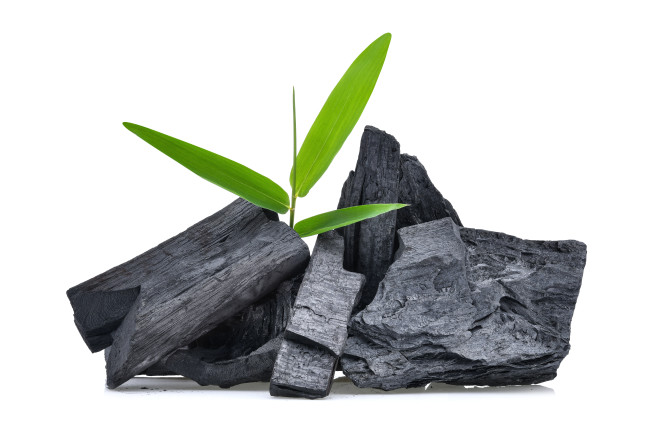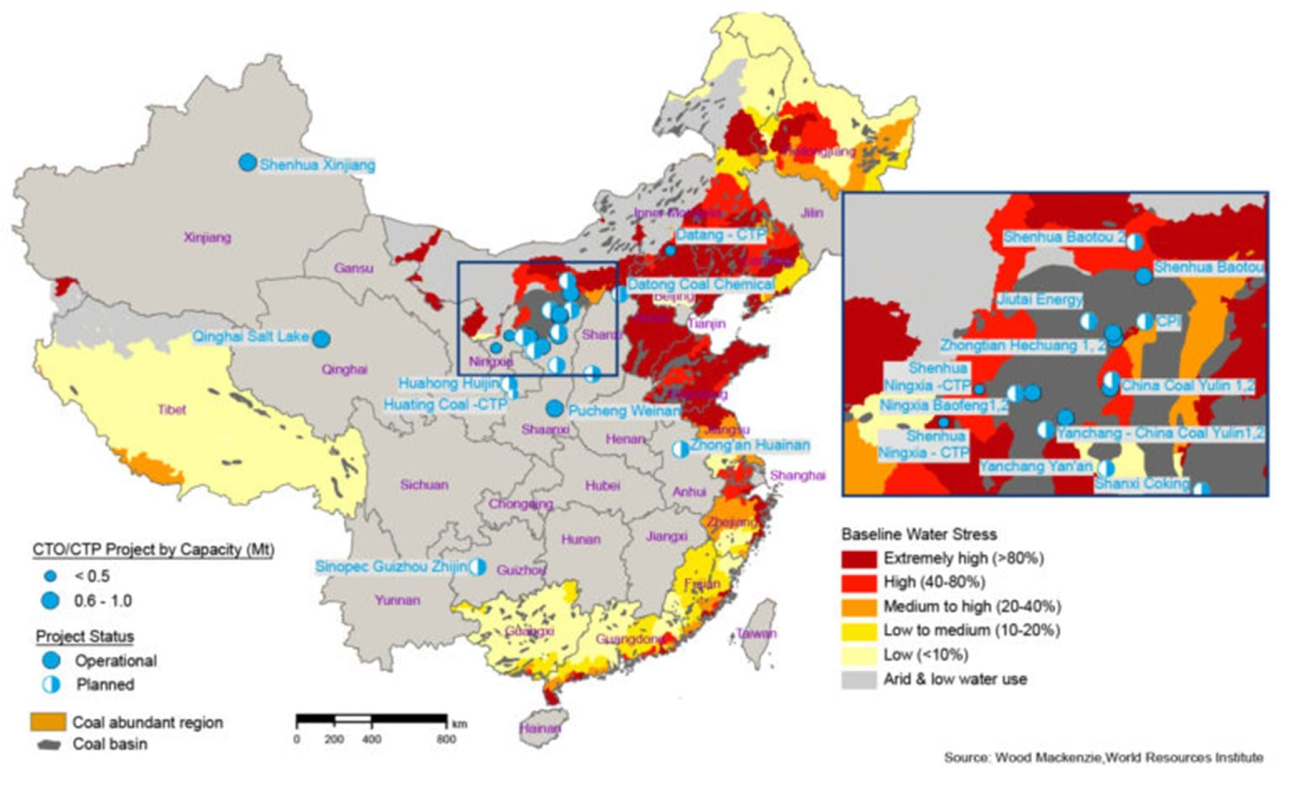-
Black Coal to White Trash
February 13, 2020 By Richard Liu
Coal has long been China’s “black gold,” supplying over half of the nation’s electricity. Yet as coal’s energy share decreases due to domestic action to reduce air pollution and greenhouse gas emissions, a new coal industry is emerging. In China’s arid northwest, eight plants are pulverizing coal chunks and “cooking” coal powder into something more valuable than power—or maybe even gold. These coal conversion plants, soon numbering over 20, churn out chemicals to produce plastic.
In China’s Thirteenth Five-Year Energy Development Plan, central policymakers set a target to decrease coal’s share in China’s energy mix. Reducing coal power puts China on track to meet its 2015 Paris Agreement commitment to peak emissions by 2030. But China’s investments in coal conversion now threaten to increase coal consumption. The risk of China deepening its coal dependency intensified at the 2019 United Nations Climate Summit, when China’s State Councilor Wang Yi made no new commitments to cut coal.
Though China has multiple coal conversion industries, such as coal-to-oil or gas, it is coal-to-plastics that Chinese companies see as having enormous growth potential. According to a report by the Center for International Environmental Law, China’s petrochemical industry could invest $100 billion into turning coal to plastics over the next five years.
China’s love affair with CTO
While most plastics are produced from natural gas or crude oil, Chinese plants are converting coal into chemicals used to produce plastics through direct coal-to-olefins (CTO) or the multistep coal-to-methanol (from coal) and then methanol-to-olefins. China is the only country to implement CTO at scale. From 2011 to 2015, China’s CTO capacity grew from 1 million tons annually (MTA) to 7.2 MTA, equivalent to 20 percent of China’s plastic feedstock capacity.
While methanol-to-olefins has become unviable in recent years due to uncompetitive methanol pricing, the profitability of CTO draws investment. According to Tian Yajun, a coal conversion expert from the National Institute of Clean and Low Carbon Energy, “CTO companies profit from high oil prices. In recent years, CTO has the best return out of all coal conversion industries because demand is high and the central government doesn’t control olefins or plastic prices.”
China’s coal mining industry has shed jobs due to automation and overcapacity, employing less than 3 million employees in 2020, down from 5.29 million in 2013. This industrial decay has resulted in social activism; miner strikes erupted after proposed layoffs in 2016. Conversion industries keep coal mining viable as an alternative source of coal demand and jobs, providing the social incentive for CTO investment.
China imports certain plastics and more than half of its plastic-producing chemicals. China is also the world’s largest oil importer and consumer, with chemicals projected to drive oil demand growth. According to a report by the Natural Resources Defense Council’s Beijing office, chemical production will consume 42.4 percent of China’s oil by 2050. Import reliance heightens China’s energy and economic insecurity, incentivizing domestic CTO production. According to Yao Wu, an energy market analyst from ESAI Energy LLC, “China relies on imports of high-value plastics, such as the material to make bumpers and other auto parts. But foreign supply could be crippled when geopolitical tensions intensify, as in the case of the U.S.-China trade war. Thus, China views domestic petrochemical production from a security perspective.”
So why don’t other countries invest in CTO at scale?
Problems from CTO Production…
To control its development, the central government mandates new CTO plants have a minimum 500 thousand ton per year capacity. For comparison, a plant with 600 thousand ton per year capacity costs approximately $2.8 billion U.S. dollars to set up. With such a steep initial investment, CTO plants only become economically feasible after years of operation and if the price of coal remains lower than oil. Regarding volatile oil prices, Yao Wu says, “When the oil price is low, CTO suffers tremendously. I don’t think it survives without policy support.”
Another hurdle is environmental. CTO emits triple the carbon as oil-to-plastics production. According to a 2017 report by Greenpeace, CTO in China is projected to produce more than 170 MTA of CO₂emissions by 2020, equivalent to 3.8 million households. In an interview with ICIS consulting, a vice president at Shell Chemicals remarked that Chinese CTO plants are “massive CO₂machines that make chemicals as a sidestream.”
Besides large carbon emissions, CTO industries consume more than 4.2 times the water as oil-to-plastics production. As Map 1 shows, most CTO projects are in water-scarce provinces, exacerbating water shortages and increasing risk of drought. CTO industries also leak polluting wastewater containing mercury and arsenic. In 2016, sewage from a CTO project in Inner Mongolia contaminated soil and groundwater, forcing the relocation of 2,200 villagers.
Figure 1. Image sourced from Wood Mackenzie article “The opportunities and challenges of CTO/MTO development”, data from World Resources Institute
…to Use of Plastic
Plastic is found in nearly every modern good, from iPhones to packaging. Describing China’s market for CTO, Tian Yajun says, “CTO mainly produces low-value plastics like bags, whose demand has increased due to a consumer lifestyle shift towards ordering online.”
Food deliveries alone accounted for 1.6 million tons of plastic packaging waste in China in 2017, a 900 percent increase from 2015. With 8 million tons of plastic flowing globally into the ocean each year, the UN Environment Programme has shown that ocean plastics destroy marine ecosystems and industries while threatening human health. China shares responsibility to clean up plastic pollution as the world’s largest contributor to the crisis.
To manage plastic waste, the Chinese government halted imports of plastic recyclables in 2018 and plans to invest $3.1 billion into waste sorting to catalyze widespread recycling programs. Yet, consumers have been slow to adapt. According to Greenpeace, 99 percent of China’s plastic packaging waste is unrecycled.
Yale Environment 360 reports China has built 231 waste-to-energy plants, aiming to incinerate one-third of municipal waste by 2030. Yet fears of incinerator-produced air pollution emissions have led to public protests about toxic pollution from burning plastic and other waste. A study conducted by Wuhu Ecology Center revealed weak Chinese emissions standards, reporting that of the 231 plants, only 77 incinerators disclosed emissions data and of those, around 20 percent failed the latest emissions standards.
Black and White Solutions
Despite problems with production and disposal, central policymakers are unlikely to rapidly shutter the CTO industry given its current profitability and importance to local coal economies. However, two policy areas would force China’s CTO industry to internalize its externalities, forcing the dirtiest to close and limit the industry’s long-term profitability.
- Pollution Control, Carbon Mitigation, and Cutting National Subsidies
- Local-level environmental agencies must improve enforcement of water regulation to avoid water shortages and contamination.
- Policymakers should expand China’s national carbon emissions-trading scheme (ETS) into the CTO industry. Forced to internalize the costs of carbon emissions, plants will mitigate emissions and invest in better technology.
- Policymakers are cutting subsidies for solar panel companies to weed out unprofitable renewable energy manufacturers. Similarly, subsidies for CTO projects should be discontinued to ensure only the “fittest” operations survive, especially when the oil price is low.
- Plastic Reduction and Waste Management Reform
- A 2018 China Zero Waste Alliance survey found that only 7 percent of surveyed retailers followed China’s then-plastic bag ban. As the central government plans to implement a 20 percent minimum recycled content standard by 2025, policymakers must improve plastic regulation enforcement.
- Central policymakers have not proposed a tax on plastic production or consumption, yet given the government’s high prioritization of waste management, such regulation is a possibility. To reduce plastic consumption and virgin plastic production, policymakers can introduce a tax on olefins production.
- China’s sprouting e-commerce and delivery industries account for 93 percent of the increase in solid waste from China’s megacities. Recently, China’s National Development and Reform Commission and Ministry of Ecology and Environment issued an opinion mandating that plastic packaging bags be biodegradable. Such a step will reduce the need for plastic production. Policymakers should continue to regulate and incentivize improved plastic quality in packaging to increase
Plastics production, use, and recycling is complicated. Policymakers must step back and consider a comprehensive plastics plan in the same way the country has adopted a Five-Year Energy Development Plan.
Special thanks to Yao Wu, Dr. Yajun Tian, Xiaomeng Ma, and Steven Feit for their contributions to this blog.
Richard Liu was a fall 2019 research intern at the China Environment Forum. He currently studies Economics at Indiana University.
Sources: 1421 Consulting Group, Center for Environmental Law, China Development Brief, China Environment Forum Insight Out, China Water Risk, ESAI Energy LLC, Greenpeace, Hong Kong and Shanghai Banking Corporation Global Research, ICIS, IEA Clean Coal Centre, International Centre for Tax and Development, National Institute of Clean and Low Carbon Energy, Natural Resources Defense Council, Ocean Conservancy, Quartz, Reuters, The Asia-Pacific Journal, The Brookings Institution, The New York Times, Trucost, UNEP, Wood Mackenzie, World Resources Institute, Xinhua, Yale Environment 360.
Photo Credit: Header image from Shutterstock.
- Pollution Control, Carbon Mitigation, and Cutting National Subsidies
 A Publication of the Stimson Center.
A Publication of the Stimson Center.








